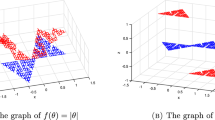Abstract
The spherical maximal operator
where σ is the surface measure on the unit sphere, is a classical object that appears in a variety of contexts in harmonic analysis, geometric measure theory, partial differential equation and geometric combinatorics.
We establish Lp bounds for the Stein spherical maximal operator in the setting of compactly supported Borel measures μ, ν satisfying natural local size assumptions \(\mu (B(x,r)) \leqslant C{r {{s_\mu }}},v(B(x,r)) \leqslant C{r {{s_v}}}\).
Taking the supremum over all t > 0 is not in general possible for reasons that are fundamental to the fractal setting, but we can obtain single scale (t ∈ [a, b] ⊂ (0,∞)) results. The range of possible Lp exponents is, in general, a bounded open interval where the upper endpoint is closely tied with the local smoothing estimates for Fourier Integral Operators.
In the process, we establish L2(μ) → L2(ν) bounds for the convolution operator Tλf(x) = λ * (fμ), where λ is a tempered distribution satisfying a suitable Fourier decay condition. More generally, we establish a transference mechanism which yields Lp(μ) → Lp(ν) bounds for a large class of operators satisfying suitable Lp-Sobolev bounds. This allows us to effectively study the dimension of a blowup set ({x: Tf(x) = ∞}) for a wide class of operators, including the solution operator for the classical wave equation. Some of the results established in this paper have already been used to study a variety of Falconer type problems in geometric measure theory.
Similar content being viewed by others
References
D. Adams, Capacity and blow-up for the 3+1 dimensional wave operator, Forum Math., 20 (2008), 341–357.
J. Bourgain, Averages in the plane over convex curves and maximal operators, J. Anal. Math., 47 (1986), 69–85.
M. Bennett, A. Iosevich and K. Taylor, Finite chains inside subsets of Rd, Anal. PDE, 9 (2016), 597–614.
S. Eswarathasan, A. Iosevich and K. Taylor, Fourier integral operators, fractal sets, and the regular value theorem, Adv. Math., 228 (2011), 2385–2402.
K. J. Falconer, The Geometry of Fractal Sets, Cambridge Tracts in Mathematics, 85, Cambridge University Press (Cambridge, 1986).
A. Iosevich, H. Jorati and I. Laba, Geometric incidence theorems via Fourier analysis, Trans. Amer. Math. Soc., 361 (2009), 6595–6611.
A. Iosevich and E. Liflyand, Decay of the Fourier Transform, Birkhauser (2014).
P. Mattila, Geometry of Sets and Measures in Euclidean Spaces, Cambridge Studies in Advanced Mathematics, 44, Cambridge University Press (Cambridge, 1995).
G. Mockenhaupt, A. Seeger and C. D. Sogge, Wave front sets, local smoothing and Bourgain’s circular maximal theorem, Ann. of Math. (2), 136 (1992), 207–218.
G. Mockenhaupt, A. Seeger and C. D. Sogge, Local smoothing of Fourier integral operators and Carleson–Sjölin estimates, J. Amer. Math. Soc., 6 (1993), 65–130.
I. Schur, Bemerkungen zur Theorie der Beschränkten Bilinearformen mit unendlich vielen Veränderlichen, J. Reine Angew. Math., 140 (1911), 1–28.
C. Sogge, Fourier Integrals in Classical Analysis, Cambridge University Press (1993).
E. M. Stein, Maximal functions: spherical means, Proc. Nat. Acad. Sci. U.S.A., 73 (1976), 2174–2175.
E. M. Stein, Harmonic Analysis, Princeton University Press (Princeton, NJ, 1993).
A. Seeger, C. D. Sogge, D. Christopher and E. M. Stein, Regularity properties of Fourier integral operators, Ann. of Math. (2), 134 (1991), 231–251.
R. Strichartz, Fourier asymptotics of fractal measures, J Func. Anal., 89 (1990), 154–187.
K. Taylor, Ph.D. Thesis, University of Rochester (2012).
T. Wolff, Lectures on Harmonic Analysis, edited by I. Laba and C. Shubin, University Lecture Series, 29, American Mathematical Society (Providence, RI, 2003).
Author information
Authors and Affiliations
Corresponding author
Rights and permissions
About this article
Cite this article
Iosevich, A., Krause, B., Sawyer, E. et al. Maximal Operators: Scales, Curvature and the Fractal Dimension. Anal Math 45, 63–86 (2019). https://doi.org/10.1007/s10476-018-0307-9
Received:
Revised:
Accepted:
Published:
Issue Date:
DOI: https://doi.org/10.1007/s10476-018-0307-9



